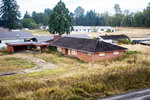

As the Centralia Station project moves forward, the Port of Centralia has addressed concerns about flooding presented by citizens, stating the port hired some of the best consultants throughout the process to ensure the new 43-acre multi-use development did not exacerbate flooding.
“The bottom line is the port has approached this cautiously,” Kyle Heaton, executive director of the port, told The Chronicle. “We’ve invested a considerable amount of money, and private investors are looking to invest a considerable amount of money. No one would do that if there wasn’t a way to mitigate flood concerns.”
Molly Lawrence, with the law firm Van Ness Feldman, said the port hired WEST Consultants, “a highly qualified technical consultant,” to model the effects of the development on flood risks in Centralia and the surrounding areas.
Lawrence’s specialty over the last 10 years includes helping clients address changes in regulations affecting development within floodplains.
“The port appreciates and understands the community’s concern regarding potential flood risk from development in the Chehalis Basin, including Centralia Station,” Lawrence said in an email. “…WEST consultants found that Centralia Station can be developed without increasing flood risk in the Chehalis Basin and without increasing flood risk to the town or surrounding areas.”
The Federal Emergency Management Agency’s existing floodplains are dated, according to Lawrence, and do not reflect the current landscape in regard to hydrology or physical changes such as highway improvements and new buildings.
To address that, WEST used a model that incorporated the most up-to-date and best available data and methodologies. That included input from the hydrologic engineering team that worked on the Chehalis Basin Environmental Impact Statement to evaluate the effects of Centralia Station. The model, according to Lawrence, includes the recent work completed on Interstate 5 by the state’s department of transportation to reduce flooding, as well as the changes to the highway at Mellen Street.
The work to address flooding concerns will continue as the project progresses. The port has constructed two stormwater ponds near the future site of Centralia Station.
“Modeling and calculations will be ongoing as Powell Development refines its site plan for the proposed Fred Meyer development,” she said. “However, local residents can be assured that any refinements to the site plan will be reviewed to ensure that they will not increase potential flood risk in the Chehalis Basin or create flood risk to the town or surrounding areas.”
Heaton said the port has worked with the state Department of Ecology, the city of Centralia and the Chehalis River Basin Flood Authority, which ran the matter by their consultants.
“At the end of the day, we have to look at the capital investment going down there,” he said. “That wouldn’t occur if we didn’t consider the problem. The bottom line is it can be done responsibly, and the port is approaching it responsibly as we did on Galvin Road, and we have a track record of success.”
Following the floods in 2007, WEST worked with the Flood Authority to develop the Chehalis River Basin Early Flood Warning System.
In September, the port announced the Federal Highway Administration approved a new ramp off the Mellen Street Interchange 5 overpass.
It was the last permit needed before construction planning for the development, which is eyeing Fred Meyer as its anchor tenant and will also include smaller storefronts, businesses and offices.
The port partnered with Powell Development in March of this year after interviewing at least six developers for Centralia Station.
Back in March, Peter Powell, CEO and founder of Powell Development, said the Fred Meyer would be a 172,000-square-foot store and would include a full fuel center, a drive thru-pharmacy and a garden center.
According to the report from ECONorthwest last year, the $53 million construction phase of the project would require 410 full-time employees and support 575 jobs throughout the local economy, adding $26.4 million to local labor income. The construction period was estimated to contribute $4.6 million in state and local taxes. The construction is expected to trigger additional local spending, according to the forecast, which would result in a one-time impact of $76.3 million.
Once the complex opened, the report estimated it would employ 535 people in Centralia at the businesses, which ECONorthwest predicted at the time would include 10 stores, four restaurants, a bank and a gas station, totaling $118 million in annual sales, according to the report. Centralia Station would earn an estimated $118 million in annual sales and pay almost $7.1 million in state and local taxes, according to the report. In the first 10 years of operation, Centralia Station would pay the present year equivalent of nearly $5 million in property taxes, according to the report.